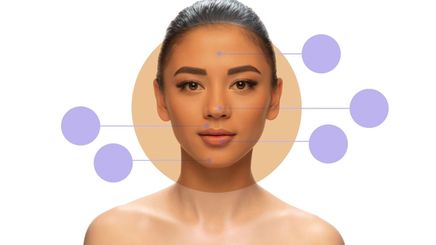
Face mapping stems from ancient Chinese and Ayurvedic beliefs that a person’s skin reflects their health. According to traditional wisdom, pimples on face signify a deeper issue, and the location of the breakout can identify what this issue is inside the body. By this logic, we would be able to figure out acne triggers and address them, instead of superficially trying to eliminate breakouts.
The fact is, there isn’t enough scientific evidence to support the link between a pimple’s placement and a possible underlying medical condition. A dermatologist’s expertise is still the most valuable when it comes to diagnosing and treating skin conditions. There is, however, evidence that specific factors contribute to acne breakouts in certain areas of the face.
Forehead Acne: Hair Products and Cosmetics
Acne occurs when . Certain comedogenic ingredients in hair products and cosmetics can contribute to clogging the skin. Pimples located near the hairline and temples, or forehead acne, may be due to particular wax or oil-based hair products. If you’re using hair products, make sure to wash them off before going to bed. This is when these products are most likely to slide onto your face.
T-Zone: Excess Sebum Production
Acne occurs when the overproduction of sebum in the sebaceous glands leads to clogged pores and inflammation. The face alone can have 900 sebaceous glands per square centimeter; some people have several on the forehead, nose, and chin. A 2010 study from the Seoul National University Bundang Hospital found a link between sebum production and acne quantity in the T-zone. If your skin is pimple-prone, shift to skincare products that are non-comedogenic and oil-free to minimize breakouts.
You'll find that the best anti-acne facial wash minimizes oil and prevents clogged pores. Try POND'S Bright Miracle Ultimate Acne Control Facial Foam, which protects acne-prone skin with salicylic acid. It eliminates acne at the root in three days and clarifies skin.
Cheeks: Friction
Friction causes a type of acne called acne mechanica. Rubbing, squeezing, or stretching the skin can trigger breakouts or worsen existing acne. Holding your phone against your face, using rough pillowcases, wearing a piece of equipment such as a helmet and even a face mask can go beyond pimples on face and may . You can also get acne mechanica on your body, especially in areas that experience friction from tight clothing or specific activities.
If your face is always in contact with things that can harbor bacteria, such as a face mask, use a gentle cleanser like POND'S Orange Nectar Jelly Cleanser. It has orange nectar extract and vitamin C that cleans as it nourishes and brightens.
Jawline: Hormonal Changes
A 2015 study in the Journal of The European Academy of Dermatology and Venereology found that up to 85% of females with acne have . The American Academy of Dermatology states that imbalances can lead to acne breakouts. These imbalances usually take place around periods, during pregnancy, and around menopause, and using or discontinuing birth control pills.
Always consult your dermatologist to properly treat pimples on face. Certain ideas in traditional face mapping may be worth remembering, but it’s always best to talk to an expert for the best treatment for any skin condition. The AAD says it’s also essential to give your acne treatment at least four weeks to work and follow instructions for use.